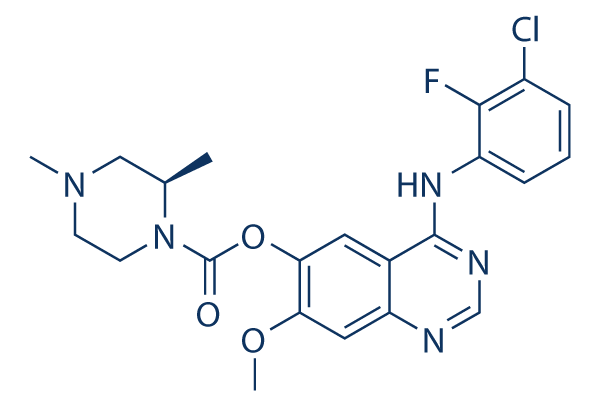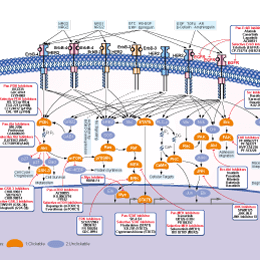
- Bioactive Compounds
- By Signaling Pathways
- PI3K/Akt/mTOR
- Epigenetics
- Methylation
- Immunology & Inflammation
- Protein Tyrosine Kinase
- Angiogenesis
- Apoptosis
- Autophagy
- ER stress & UPR
- JAK/STAT
- MAPK
- Cytoskeletal Signaling
- Cell Cycle
- TGF-beta/Smad
- DNA Damage/DNA Repair
- Compound Libraries
- Popular Compound Libraries
- Customize Library
- Clinical and FDA-approved Related
- Bioactive Compound Libraries
- Inhibitor Related
- Natural Product Related
- Metabolism Related
- Cell Death Related
- By Signaling Pathway
- By Disease
- Anti-infection and Antiviral Related
- Neuronal and Immunology Related
- Fragment and Covalent Related
- FDA-approved Drug Library
- FDA-approved & Passed Phase I Drug Library
- Preclinical/Clinical Compound Library
- Bioactive Compound Library-I
- Bioactive Compound Library-Ⅱ
- Kinase Inhibitor Library
- Express-Pick Library
- Natural Product Library
- Human Endogenous Metabolite Compound Library
- Alkaloid Compound LibraryNew
- Angiogenesis Related compound Library
- Anti-Aging Compound Library
- Anti-alzheimer Disease Compound Library
- Antibiotics compound Library
- Anti-cancer Compound Library
- Anti-cancer Compound Library-Ⅱ
- Anti-cancer Metabolism Compound Library
- Anti-Cardiovascular Disease Compound Library
- Anti-diabetic Compound Library
- Anti-infection Compound Library
- Antioxidant Compound Library
- Anti-parasitic Compound Library
- Antiviral Compound Library
- Apoptosis Compound Library
- Autophagy Compound Library
- Calcium Channel Blocker LibraryNew
- Cambridge Cancer Compound Library
- Carbohydrate Metabolism Compound LibraryNew
- Cell Cycle compound library
- CNS-Penetrant Compound Library
- Covalent Inhibitor Library
- Cytokine Inhibitor LibraryNew
- Cytoskeletal Signaling Pathway Compound Library
- DNA Damage/DNA Repair compound Library
- Drug-like Compound Library
- Endoplasmic Reticulum Stress Compound Library
- Epigenetics Compound Library
- Exosome Secretion Related Compound LibraryNew
- FDA-approved Anticancer Drug LibraryNew
- Ferroptosis Compound Library
- Flavonoid Compound Library
- Fragment Library
- Glutamine Metabolism Compound Library
- Glycolysis Compound Library
- GPCR Compound Library
- Gut Microbial Metabolite Library
- HIF-1 Signaling Pathway Compound Library
- Highly Selective Inhibitor Library
- Histone modification compound library
- HTS Library for Drug Discovery
- Human Hormone Related Compound LibraryNew
- Human Transcription Factor Compound LibraryNew
- Immunology/Inflammation Compound Library
- Inhibitor Library
- Ion Channel Ligand Library
- JAK/STAT compound library
- Lipid Metabolism Compound LibraryNew
- Macrocyclic Compound Library
- MAPK Inhibitor Library
- Medicine Food Homology Compound Library
- Metabolism Compound Library
- Methylation Compound Library
- Mouse Metabolite Compound LibraryNew
- Natural Organic Compound Library
- Neuronal Signaling Compound Library
- NF-κB Signaling Compound Library
- Nucleoside Analogue Library
- Obesity Compound Library
- Oxidative Stress Compound LibraryNew
- Plant Extract Library
- Phenotypic Screening Library
- PI3K/Akt Inhibitor Library
- Protease Inhibitor Library
- Protein-protein Interaction Inhibitor Library
- Pyroptosis Compound Library
- Small Molecule Immuno-Oncology Compound Library
- Mitochondria-Targeted Compound LibraryNew
- Stem Cell Differentiation Compound LibraryNew
- Stem Cell Signaling Compound Library
- Natural Phenol Compound LibraryNew
- Natural Terpenoid Compound LibraryNew
- TGF-beta/Smad compound library
- Traditional Chinese Medicine Library
- Tyrosine Kinase Inhibitor Library
- Ubiquitination Compound Library
-
Cherry Picking
You can personalize your library with chemicals from within Selleck's inventory. Build the right library for your research endeavors by choosing from compounds in all of our available libraries.
Please contact us at [email protected] to customize your library.
You could select:
- Antibodies
- Bioreagents
- qPCR
- 2x SYBR Green qPCR Master Mix
- 2x SYBR Green qPCR Master Mix(Low ROX)
- 2x SYBR Green qPCR Master Mix(High ROX)
- Protein Assay
- Protein A/G Magnetic Beads for IP
- Anti-Flag magnetic beads
- Anti-Flag Affinity Gel
- Anti-Myc magnetic beads
- Anti-HA magnetic beads
- Magnetic Separator
- Poly DYKDDDDK Tag Peptide lyophilized powder
- Protease Inhibitor Cocktail
- Protease Inhibitor Cocktail (EDTA-Free, 100X in DMSO)
- Phosphatase Inhibitor Cocktail (2 Tubes, 100X)
- Cell Biology
- Cell Counting Kit-8 (CCK-8)
- Animal Experiment
- Mouse Direct PCR Kit (For Genotyping)
- New Products
- Contact Us
Zorifertinib (AZD3759)
Zorifertinib (AZD3759) is a potent, oral active, CNS-penetrant EGFR inhibitor with IC50 of 0.3 nM, 0.2 nM, and 0.2 nM for EGFR (WT), EGFR (L858R), and EGFR (exon 19Del), respectively. Phase 1.

Zorifertinib (AZD3759) Chemical Structure
CAS No. 1626387-80-1
Purity & Quality Control
Batch:
Purity:
99.87%
99.87
Zorifertinib (AZD3759) Related Products
Signaling Pathway
Cell Data
| Cell Lines | Assay Type | Concentration | Incubation Time | Formulation | Activity Description | PMID |
|---|---|---|---|---|---|---|
| H3255 cells | Proliferation assay | 72 h | Antiproliferative against human H3255 cells expressing EGFR L858R mutant after 72 hrs by MTS assay, IC50=0.007 μM | 26313252 | ||
| PC9 cells | Function assay | Inhibition of EGFR exon19 deletion mutant phosphorylation in human PC9 cells, IC50=0.0074 μM | 26313252 | |||
| H838 cells | Function assay | Inhibition of EGFR phosphorylation in human H838 cells, IC50=0.0645 μM | 26313252 | |||
| Click to View More Cell Line Experimental Data | ||||||
Biological Activity
| Description | Zorifertinib (AZD3759) is a potent, oral active, CNS-penetrant EGFR inhibitor with IC50 of 0.3 nM, 0.2 nM, and 0.2 nM for EGFR (WT), EGFR (L858R), and EGFR (exon 19Del), respectively. Phase 1. | ||||||
|---|---|---|---|---|---|---|---|
| Targets |
|
| In vitro | ||||
| In vitro | In H3255 (L858R) cells, AZD3759 inhibits EGFR phosphorylation with IC50 of 7.2 nM. AZD3759 demonstrates inhibitory effects on both the pEGFR pathway and cell proliferation of EGFR mutation-derived cells PC-9 and H3255 with IC50 of 7.7 nM and 7 nM, respectively, showing mo activity on cell proliferation of H838 cells. [1] | |||
|---|---|---|---|---|
| Kinase Assay | IC50 determination of compounds against EGFR enzymes | |||
| The inhibition potency of compounds against EGFR WT and mutant enzymes is assessed using CisBio homogenous time resolved fluorescence approach (HTRF, Cat No. 62TK0PEJ) according to manufacturer’s instruction. The final enzyme concentrations used in this assay are 0.1 nM, 0.03 nM, and 0.026 nM for EGFR wild type, L858R and Exon19Del, respectively, and 0.8 μM, 4 μM and 25 μM ATP, corresponding to the Km values of EGFR enzymes, are applied accordingly. In brief, 3 μL of ATP and 2 μM TK biotin-peptide substrate are incubated in the presence or absence of serially diluted compound at room temperature in 384-well Greiner white polystyrene assay plates. The reaction is initiated by addition of 3 μL kinase which could phosphorylate the substrate peptide, and the assay buffer contains 1 mM DTT, 5 mM MgCl2, 1 mM MnCl2, and 0.01% CHAPS. After 30 minutes incubation, the reaction is stopped by the addition of 6 μl detection reagent mix containing 250 nM Strep-XL665 and TK Ab Europium Cryptate diluted in detection buffer. The plates are incubated for 1 h before the fluorescence is then measured at 615 nm and 665 nm, respectively with excitation wavelength at 320 nm by EnVision Multilabel Reader from Perkin Elmer using standard HTRF settings. The calculated signal ratio of 665 nm/615 nm is proportional to the kinase activity. The concentration of compound producing 50% inhibition of the respective kinase (IC50) is calculated using four-parameter logistic fit. | ||||
| Cell Research | Cell lines | PC-9 (exon 19Del), H3255 (L858R) and H838 (wt) cells | ||
| Concentrations | ~30 mM | |||
| Incubation Time | 72 h | |||
| Method | Cell proliferation assay is determined by MTS methods. Briefly, cells are seeded in 96-well plates (at a density to allow for logarithmic growth during the 72-hour assay) and incubated overnight at 37 °C and 5% CO2. Cells are then exposed to concentrations of compounds ranging from 30 to 0.0003 mM for 72 hours. For the MTS endpoint, cell proliferation is measured by the CellTiter AQueous Non-Radioactive Cell Proliferation Assay reagent in accordance with the manufacturer’s protocol. Absorbance is measured with a Tecan Ultra instrument. Predose measurements are made, and concentration needed to reduce the growth of treated cells to half that of untreated cells (GI50) values are determined using absorbance readings. | |||
| In Vivo | ||
| In vivo | AZD3759 shows good oral bioavailability in dogs, and penetrates extensively into monkey brain. In a brain metastasis PC-9 (Exon19Del) model, AZD3759 (15 mg/kg) causes significant dose-dependent antitumor efficacy. [1] | |
|---|---|---|
| Animal Research | Animal Models | Mice bearing PC-9 (Exon19Del) tumors |
| Dosages | ~15 mg/kg | |
| Administration | p.o. | |
| NCT Number | Recruitment | Conditions | Sponsor/Collaborators | Start Date | Phases |
|---|---|---|---|---|---|
| NCT02228369 | Completed | EGFR Mutation Positive Advanced Non Small Cell Lung Cancer |
AstraZeneca |
November 5 2014 | Phase 1 |
Chemical Information & Solubility
| Molecular Weight | 459.90 | Formula | C22H23ClFN5O3 |
| CAS No. | 1626387-80-1 | SDF | Download Zorifertinib (AZD3759) SDF |
| Smiles | CC1CN(CCN1C(=O)OC2=C(C=C3C(=C2)C(=NC=N3)NC4=C(C(=CC=C4)Cl)F)OC)C | ||
| Storage (From the date of receipt) | |||
|
In vitro |
DMSO : 91 mg/mL ( (197.86 mM) Moisture-absorbing DMSO reduces solubility. Please use fresh DMSO.) Ethanol : 20 mg/mL Water : Insoluble |
Molecular Weight Calculator |
|
In vivo Add solvents to the product individually and in order. |
In vivo Formulation Calculator |
||||
Preparing Stock Solutions
Molarity Calculator
In vivo Formulation Calculator (Clear solution)
Step 1: Enter information below (Recommended: An additional animal making an allowance for loss during the experiment)
mg/kg
g
μL
Step 2: Enter the in vivo formulation (This is only the calculator, not formulation. Please contact us first if there is no in vivo formulation at the solubility Section.)
% DMSO
%
% Tween 80
% ddH2O
%DMSO
%
Calculation results:
Working concentration: mg/ml;
Method for preparing DMSO master liquid: mg drug pre-dissolved in μL DMSO ( Master liquid concentration mg/mL, Please contact us first if the concentration exceeds the DMSO solubility of the batch of drug. )
Method for preparing in vivo formulation: Take μL DMSO master liquid, next addμL PEG300, mix and clarify, next addμL Tween 80, mix and clarify, next add μL ddH2O, mix and clarify.
Method for preparing in vivo formulation: Take μL DMSO master liquid, next add μL Corn oil, mix and clarify.
Note: 1. Please make sure the liquid is clear before adding the next solvent.
2. Be sure to add the solvent(s) in order. You must ensure that the solution obtained, in the previous addition, is a clear solution before proceeding to add the next solvent. Physical methods such
as vortex, ultrasound or hot water bath can be used to aid dissolving.
Tech Support
Answers to questions you may have can be found in the inhibitor handling instructions. Topics include how to prepare stock solutions, how to store inhibitors, and issues that need special attention for cell-based assays and animal experiments.
Tel: +1-832-582-8158 Ext:3
If you have any other enquiries, please leave a message.
* Indicates a Required Field
Tags: buy Zorifertinib (AZD3759) | Zorifertinib (AZD3759) supplier | purchase Zorifertinib (AZD3759) | Zorifertinib (AZD3759) cost | Zorifertinib (AZD3759) manufacturer | order Zorifertinib (AZD3759) | Zorifertinib (AZD3759) distributor







































